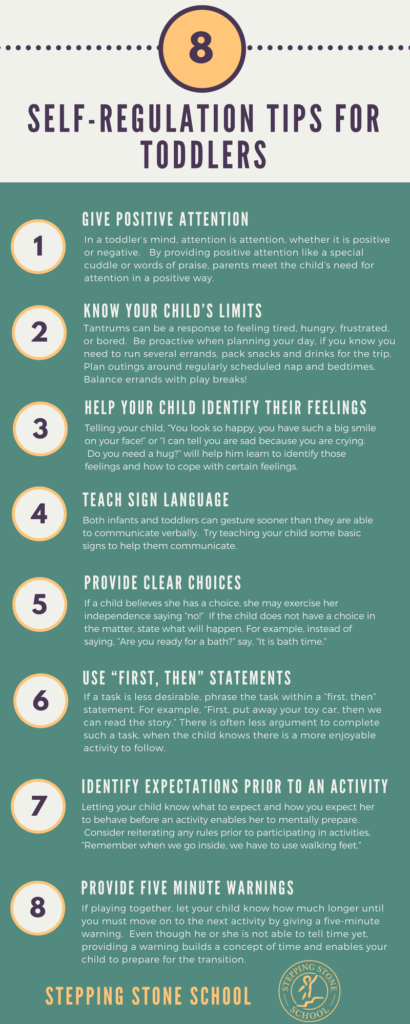Self-Regulation Tips for Toddlers
At Stepping Stone School, we strive to support our families through the many ups and downs of early childhood. The toddler years are a pivotal time in the life of a child. No longer infants, toddlers are transitioning, developing communication skills, and gaining independence. This developmental stage is both exciting and challenging as we share in the joy of discovery, but also the frustration of toddler tantrums.
Fortunately, experts provide several ideas to reduce the number of tantrums:
- Give Positive Attention. In a toddler’s mind, attention is attention, whether it is positive or negative. Sears calls attention seeking tantrums a “Manipulative Tantrum.” By providing positive attention like a special cuddle or words of praise, parents meet the child’s need for attention in a positive way. (Sears, 2012)
- Know Your Child’s Limits. Tantrums can be a response to feeling tired, hungry, frustrated, or bored. Be proactive when planning your day, if you know you need to run several errands, pack snacks and drinks for the trip. Plan outings around regularly scheduled nap and bedtimes. Balance errands with play breaks so your child does not get bored.
- Help Your Child Identify How He Is Feeling. Telling your child, “You look so happy, you have such a big smile on your face!” or “I can tell you are sad because you are crying. Do you need a hug?” will help him learn to identify those feelings and how to cope with certain feelings.
- Teach Sign Language. Both infants and toddlers can gesture sooner than they are able to communicate verbally. Some simple signs to begin teaching your child include:
Food
Drink
More
All finished
Stop
Help
Please
Thank you/Your Welcome
- Provide Clear Choices. If a child believes she has a choice, she may exercise her independence saying “no!” If the child does not have a choice in the matter, state what will happen. For example, instead of saying, “Are you ready for a bath?” say, “It is bath time.”
- Use “first, then” Statements. If a task is less desirable, phrase the task within a “first, then” statement. For example, “First, put away your toy car, then we can read the story.” There is often less argument to complete such a task, when the child knows there is a more enjoyable activity to follow.
- Identify Expectations Prior to an Activity. Letting your child know what to expect and how you expect her to behave before an activity enables her to mentally prepare. Consider reiterating any rules prior to participating in activities, “Remember when we go inside, we have to use walking feet.”
- Provide Five Minute Warnings. If playing together, let your child know how much longer until you must move on to the next activity by giving a five-minute warning. Even though he or she is not able to tell time yet, providing a warning builds a concept of time and enables your child to prepare for the transition.

Despite our best efforts, tantrums are still considered a “normal” part of the toddler years. When a tantrum occurs, there are certain steps parents can take to deescalate the situation.
- Remain Calm. When you remain calm, you can regain control of the situation more quickly. Your calming presence will help your child become calm.
- Identify the trigger and purpose of a tantrum. Think about what caused your child to get upset. Is it because he is tired? Is she frustrated with something? Considering the cause and purpose of a tantrum allows you to know whether to ignore the behavior or intervene immediately.
- Ignore what you can. If the purpose of a tantrum is to manipulate the situation, the best response is to ignore the behavior as long as she is safe. However, if the tantrum is a result of frustration, it is better to respond immediately.
- Use Distraction Techniques. By helping your child focus his attention on something else, he may forget why he was upset in the first place.
Helping your child regain control after a tantrum and teaching him how to communicate his needs early on will support his social development. Celebrate your child’s desire for independence and cherish the moments he comes to you for help. Remember the toddler years are part of a developmental stage – they will pass.
Resources: